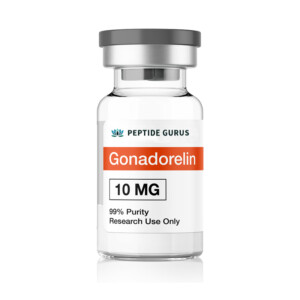Introduction
Prostate cancer is one of the most prevalent cancers among men. Hormonal therapies play a crucial role in its treatment, and the
gonadorelin peptide has emerged as a significant player in this field. This article will explore how gonadorelin peptide functions, its relationship with prostate cancer treatment, and relevant FDA guidelines.
What is Gonadorelin Peptide?
Gonadorelin, also known as gonadotropin – releasing hormone (GnRH), is a synthetic decapeptide. Structurally, it has the sequence pyr – his – trp – ser – tyr – gly – leu – arg – pro – gly, with a molecular formula of C55H75N17O13 and a molecular weight of 1182.311 g/mol. It mimics the action of the naturally occurring GnRH produced in the hypothalamus of the brain.
GnRH agonists like gonadorelin work by binding to GnRH receptors in the anterior pituitary gland. This binding initially stimulates the release of luteinizing hormone (LH) and follicle – stimulating hormone (FSH). However, with continuous use, it leads to receptor down – regulation, which ultimately decreases the secretion of LH and FSH. In the context of the male reproductive system, LH stimulates the Leydig cells in the testicles to produce testosterone. By reducing LH secretion through continuous administration of gonadorelin, testosterone production can be suppressed.
Prostate Cancer and Hormonal Dependence
Prostate cancer cells often rely on androgens, such as testosterone, for their growth and survival. High levels of testosterone can fuel the progression of prostate cancer. This hormonal dependence of prostate cancer is both a challenge and an opportunity for treatment. If the supply of testosterone can be reduced, it may slow down or even stop the growth of prostate cancer cells.
Gonadorelin Peptide in Prostate Cancer Treatment
Mechanism of Action in Prostate Cancer
In prostate cancer treatment, the goal is to reduce the levels of testosterone available to cancer cells. Gonadorelin, when administered continuously, down – regulates the GnRH receptors in the pituitary gland. This leads to decreased secretion of LH, which in turn reduces the production of testosterone by the testicles. With lower testosterone levels, prostate cancer cells have less of the hormone they need to grow and divide, potentially slowing the progression of the disease.
Clinical Evidence and Research
Research has shown promising results regarding the use of gonadorelin in prostate cancer treatment. For example, some studies have observed that patients with prostate cancer who received gonadorelin – based therapies experienced a significant reduction in testosterone levels. A study published in the Journal of Urology found that the use of gonadorelin in androgen deprivation therapy (ADT) for castration – sensitive prostate cancer significantly reduced testosterone breakthrough rates. This indicates that gonadorelin can effectively suppress testosterone levels and help manage the disease.
The FDA has also been involved in regulating treatments related to prostate cancer and hormonal therapies. While gonadorelin itself may not be directly approved by the FDA for prostate cancer treatment in its current form, the agency has approved other GnRH agonists and related hormonal therapies for advanced prostate cancer. These approvals are based on the understanding of the role of hormones in prostate cancer growth and the effectiveness of drugs that target the hormonal axis. The approval process takes into account factors such as the drug’s safety, efficacy, and potential side effects.
Side Effects and Considerations
Like any medical treatment, the use of
gonadorelin in prostate cancer treatment is not without potential side effects. Some of the common side effects associated with GnRH agonists, including gonadorelin, may include hot flashes, fatigue, loss of libido, erectile dysfunction, and decreased bone density. These side effects occur because of the reduced testosterone levels in the body, which can affect various physiological functions.
It’s important for patients to discuss these potential side effects with their healthcare providers. In some cases, additional medications or lifestyle modifications may be recommended to manage these side effects. For example, to counteract the decrease in bone density, patients may be prescribed calcium and vitamin D supplements or medications to strengthen bones.
FAQs
1. How is gonadorelin administered for prostate cancer treatment?
Gonadorelin can be administered by injection into a blood vessel or fat. In some cases, it may also be available as a nasal spray, although injection is more common in the context of prostate cancer treatment. The dosage and frequency of administration are determined by the patient’s condition and the treatment protocol, which is typically designed by the healthcare provider.
2. Can gonadorelin cure prostate cancer?
Gonadorelin is not a cure for prostate cancer. However, it can be an effective part of a treatment plan, especially for hormone – sensitive prostate cancer. By reducing testosterone levels, it can slow down the growth of cancer cells and help manage the disease, improving the patient’s quality of life and potentially extending survival. But it is usually used in combination with other treatments such as chemotherapy, radiation therapy, or surgery.
3. Are there any long – term risks associated with using gonadorelin for prostate cancer?
Long – term use of gonadorelin may lead to a decrease in bone density, which can increase the risk of fractures over time. There may also be potential impacts on cardiovascular health, although the exact nature and extent of these risks are still being studied. Regular monitoring of bone density and cardiovascular health is often recommended for patients on long – term gonadorelin therapy.
